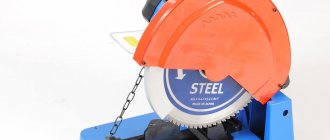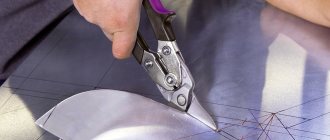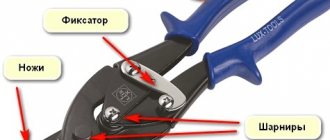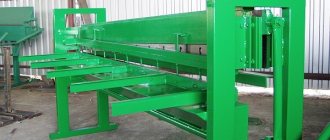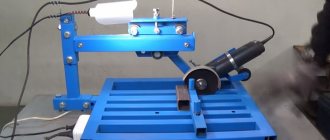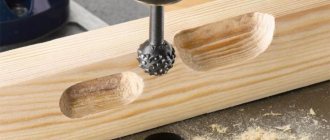To cut thin sheet metal into strips or shaped workpieces, different tools are used: mechanical metal shears, as well as electrical devices (a jigsaw, an angle grinder with a cutting wheel), including special attachments for an electric drill or screwdriver - for example, a “cricket” type attachment.
In addition to the tools listed, you can also use roller shears for cutting sheet metal. They are easy to manufacture and very convenient to use.
Lever shear device
The operation of manual metal shears is based on the principle of leverage. The cutting of the material is carried out by two cutting surfaces about 20 cm long. In this case, one surface is rigidly fixed to the base, and all the pressure is applied here. The movable cutter is also fixed to the frame. A groove is selected in the fixed blade to move the slider. It moves like a hinge in one plane.
The movable part of the scissors is attached to the slider. The working stroke of the slider is 15 - 32 mm. The movable panel is equipped with a long handle (about 50 cm), which increases the applied force by 20 times or more. Therefore, metal is cut quite easily.
The body of the lever scissors is metal, the cutting surfaces are made of tool steel. On average, the dimensions of the instrument are 56 x 18 x 45 cm and weighs about 30 kg. Using such equipment, you can cut a steel sheet with a thickness of 0.5 cm, aluminum or brass 0.6 mm, a profile with a section of 6x70 mm or a steel rod No. 13 with your own hands.
Principle of cutting process
In metalworking, cutting is the cutting of metal, as well as the separation of workpieces from it piece by piece. This process can be done using scissors. A sheet of workpiece is located between the blades of the tool. Under the pressure of the upper knife lowered onto the sheet, the metal is cut . The sharpening angle of the knife blade depends on the hardness of the metal. The harder the metal, the sharper the blade should be. The sharpening angle is:
- for soft metals - 65º;
- with medium hardness - 70−75º;
- for hard metals - 80−85º.
In order to reduce friction on the knife blades, the clearance angle should be from 1.5º to 3º.
The knives of the device are made of alloy steel. The side surfaces of the blades must be hardened , sharpened and ground.
Types of lever scissors
The designs of lever cutters do not differ in variety; the main difference is in the type of drive:
- manual - the most primitive device; by pressing the lever, the cutting blade is set in motion;
- electric - they work very quickly and are highly efficient. Cutting metal on such equipment does not require any effort from the worker;
- hydraulic - powerful, driven by a hydraulic drive. Widely used when large forces are required, for example, for cutting reinforcement or rods.
Hand scissors are divided depending on their purpose and design:
- with straight blades - used only for cutting in a straight line;
- with curved cutters - they are used to cut out complex shaped elements and holes;
- chair - used for cutting thick layers of paper;
- finger - make holes with very thin incisors;
- lever - permanently mounted on a workbench.
The manual lever attachment allows for through or straight cutting on a straight line only.
In addition, the tools differ in the length of the actuators:
- with short blades for through cutting;
- with long cutting surfaces - for straight cutting;
- combined scissors for all types, including contour scissors.
Cutting small parts with lever scissors is impossible; they are convenient for large cutting or chopping work.
The tool can be stationary or portable. For work, both types are firmly fixed on a workbench or bed. This is the only way to cut metal accurately and safely. To secure portable scissors, use clamps or bolts.
Cutting rules
Basic rules that must be applied when cutting sheet metal with hand scissors:
- When marking a part that needs to be cut, you need to provide an allowance for subsequent processing.
- Position the sheet to be cut strictly perpendicular to the blades of the tool.
- Cutting should be done in mittens with sharpened scissors.
- To avoid tearing the metal, you do not need to bring the device completely together at the end of the cut.
- It is necessary to tighten the screw axis if the tool begins to crush the workpiece material.
- If it is difficult to press the handles of the device or the thickness of the metal is 0.5 mm or more, you need to secure one of the handles in a vice.
- The size of the “cut” in the corners should not be more than 0.5 mm.
- If you need to cut a part with a curved shape, first cut the workpiece with a straight cut with an allowance of five to six millimeters, then cut the part clockwise according to the markings.
Rules for working with lever shears
Before starting work, you must put on seals so as not to get cut by the sharp edges of the metal sheet!
- Firmly fix the hand tool on the table surface;
- place the sheet of metal perpendicular to the blades, holding it with your main hand (right hand for right-handers);
- Smoothly and carefully press the handle from top to bottom.
While working, you need to protect your feet from falling pieces of cut metal. Falls on the edge are especially dangerous, so you should not work barefoot or in open shoes. To install the scissors, choose only a solid, non-wobbly base.
Homemade lever scissors
Option 1
- The frame of this model of hand scissors is assembled with your own hands from a pair of corners 7.5 x 7.5 x 0.8 cm. The fixed knife is attached to a horizontal base using a pair of screws. To align with the movable blade, the top of the base is cut in half. Holes are made in the blades, countersunk for M8 screws 24 mm long, countersunk.
- On the upper base, with the help of hinge fasteners, the following are installed: on the lower surface, the blade and lever of the knife (dimensions 6.5 x 3 x 0.6 cm), on the upper part, the lever (24.5 x 1.8 x 0.7 cm) and the earring (6 x 1.8 x 7 cm), providing mobility.
The blanks are cut out with your own hands using a hacksaw. The blades are machined from hardened steel, the sharpening angle is 30 degrees.
First, we assemble all the parts into the finished machine and set it up. Then we take it apart and paint it. When the paint dries, we assemble it clean.
Since the presented structure is quite small, it is mounted on a workbench in a vice. You can install the tool permanently on a workbench. To do this, the base is welded to a corner, which is screwed to the workbench. Spacers are used to adjust the blade ratio.
Option 2
This model of hand scissors is complemented by a detailed drawing. Metal cutting is done with a pair of blades, each 10 cm long. The movable blade is attached to the slide on a crank mechanism. The crank eccentricity is 16 mm and gives a maximum amplitude of 3.2 cm. We attach a 50 cm long handle to its tail.
It is recommended to make a stationary version of the scissors, which will be securely attached once to the working surface with M10 bolts. For fastening, paws with holes are provided. The body of lever hand scissors must be made of high-quality steel 45 or 40, and the blades from grades P18, P9 or U10.
Scissors made according to this drawing have been working successfully for more than 2 years, coping with steel sheets up to 3.5 mm thick.
Video with a detailed description of the drawings, design and manufacture of lever metal shears:
Classification of tools
Metal shears are used for cutting wire, fasteners, sheet metal, corrugated sheets and other materials. They are classified according to various criteria.
Ordinary manual
Such tools are produced for cutting sheets of steel and non-ferrous metals. The thickness of steel sheets can be from 0.5 mm to 1 mm, and non-ferrous sheets up to 1.5 mm. They are manufactured:
- with cutting blades;
- with straight blades;
- with curved blades.
Depending on how the blades and cutting edge are located, they are divided:
Right-handed are models
cutting part has a bevel on the right side.
They cut along the left edge of the sheet in a clockwise direction. Left-handed is a tool that cuts along the right edge of the workpiece in a counterclockwise direction and has a bevel on the cutting part on the left side.
The length of the tool can be from 200 mm to 400 mm, and the cutting part from the hinge to the sharp ends can be from 55 mm to 130 mm. If they are well sharpened and adjusted, they should cut paper.
Most tools are manufactured in a left-handed version , which corresponds to GOST 7210–75.
Chairs
Chair shears cut sheet metal. Its thickness can be up to 3 mm. They differ from ordinary ones in their large size. Chair shears require physical effort to cut the workpiece, which reduces labor productivity. During operation, the lower part of the tool must be secured to a hard surface.
Manual small-sized power
The type of such devices is used for cutting rods up to 8 mm in diameter and sheet steel up to 2.5 mm in thickness. They are the same size as ordinary hand scissors.
The lower handle of the tool is secured in a vice, and the working handle is activated. The knives of the tool are replaceable; they are attached to the levers with secret rivets
How to make a guillotine for cutting metal with your own hands?
In a home workshop or small business producing products from thin sheet metal, sheet metal shears, more simply - a guillotine - will never be superfluous. The driven version can be installed, for example, in a garage, and a manual guillotine will not take up much space at all. If you have a fairly large number of manufacturing options (in drawings, videos or descriptions), as well as some adapted components from some decommissioned equipment, making homemade metal shears is an accessible reality.
Conducting a test
Screw the bottom sole of the scissors to the workbench. Scissors successfully cut metal plates of different thicknesses.
DIY metal scissors. Master Class
DIY metal scissors ✂️ | Metal mode with a slight movement of the hand
Feedback from our readers is very important to us. Leave your rating in the comments with reasons for your choice. Your opinion will be useful to other users.
The work of the simplest metal scissors
The principle of cutting with guillotine (sheet) shears is that the knife beam of the device, to which the movable part of the tool is attached, along the working end must have an angle of 1.5...3°, as a result of which metal cutting occurs non-simultaneously across the entire width. This reduces the cutting force, but requires a technique that would compensate for the shear of sheet metal (tin, thick cardboard, etc.) during cutting. Thus, a reliable clamp is required.
The main components of the saber guillotine
To drive a homemade guillotine, you can use a low-power electric motor, since the energy intensity of the process is low. But based on the results of calculating the maximum cutting force, a manual drive, for example, a lever type, is often sufficient (this is often what is offered in home-made devices). You will also need reliable guidance of moving parts during the cutting process, as well as a rigid support surface for the bed. In this case, the parts of the homemade guillotine and the product itself will not be elastically deformed.
The drawings usually indicate the limits of the thickness and width of the sheet metal or tin for which the device is designed. If the entire process of obtaining sheet shears with your own hands is carried out independently, then the design begins with clarifying the power characteristics of cutting and choosing a mechanism diagram.
The initial data for choosing a design are:
- the type of material with which operations will be performed;
- maximum sheet dimensions in terms of thickness, length and width;
- separation accuracy;
- maximum overall dimensions of scissors;
- type of drive.
What can knives be made from?
In the case of making such a tool yourself, the main problem is to choose the appropriate material that will cut metal workpieces.
So, if it is necessary to cut not the most durable sheet metal - aluminum, galvanized steel, etc., a good solution would be to use ordinary bearings, the ends of which must first be sharpened.
To cut such knives into metal, one of the rollers, the drive one, must be installed on a handle with which you can press the knives to the material. After this, all that remains is to pull the metal, holding the handle of the homemade machine pressed to the base.
Thus, now you can find many designs of homemade roller cutting shears. The most difficult thing is to find parts that can be used as knives. To make it more convenient to use a do-it-yourself machine, it can be additionally equipped with guides that will allow you to cut the workpiece smoothly.
In this case, the finished tool, if necessary, can be installed on any metalworking equipment, for example, on a sheet bending machine.
Mechanical guillotine shears
The manual device is the simplest in design. It includes:
- support table on which the initial workpiece will be located;
- two or four racks that will provide the scissors with strength and stability;
- a rotary axis with plain bearings (rolling bearings are unsuitable, since the clearances during operation of such a guillotine will change significantly, which will quickly lead to jamming);
- a knife beam, which provides seats for fastening replaceable knives;
- fixed knives, which are mounted on the front end surface of the work table;
- a rotary lever that will forcefully move the beam during cutting;
- clamps for fixing metal.
Do-it-yourself production starts from the table. Its dimensions must be sufficient for convenient placement of the workpiece, taking into account the places for fixing clamps: there must be at least two of them, on each side of the sheet. The thickness should prevent deflection under deformation forces. The easiest way is to use a steel plate, which you install on the channels yourself. The joints can be bolted flush with the top surface, or welding can be used. The front end must be ground to ensure evenness of the subsequent fit of the stationary knife to it.
The next stage is to obtain support posts with your own hands. They must be made from a solid profile. Square pipes made of high-quality medium-carbon steel or a channel are suitable. The section size can be easily calculated from the maximum load on the racks, which is the sum of the self-weight of the components of manual guillotine shears for metal, and the cutting force P, kN.
The latter is calculated according to the dependence:
k is a coefficient that takes into account possible unevenness of the working gap, bluntness of cutting edges, quality of the material being cut, etc. Typically k = 1.05…1.3;
B – maximum width of the metal sheet, mm;
s – maximum metal thickness, mm;
σav – ultimate shear strength of the material, MPa.
For the materials most commonly used in everyday life, this parameter is, MPa:
- for low-carbon steel – 280…290;
- for medium carbon steel – 300...400;
- for high carbon and stainless steel – 400…500;
- for sheet metal, aluminum – 65...80;
- for copper, brass – 180...200.
When assembling the racks with your own hands, it is imperative to maintain the parallelism of the supporting surfaces and their perpendicularity to the axis of rotation of the knife beam. For these purposes, it is better to use a laser level. The floor where the scissors are installed must be made level and durable. Do-it-yourself installation of equipment on compacted soil, laminate and other options for coating concrete with polymers is not allowed.
A particularly important moment is making a knife beam with your own hands: its profile must be made such that during the turning process the movable knives gradually come into contact with the metal being cut. There are two options for this:
- profiling along the contour of the saber, with a gradual increase in the radius of curvature as it approaches the lever handle;
- pyramidal profile with a bevel angle of no more than 5...60 (at a larger angle, the metal will begin to deform and bend in the direction of the rotation axis).
The saber-shaped profile is more difficult to make, but it provides a smoother integration into the metal being cut.
For better direction of the body, it is placed either in a special groove on the table, or - with increased deformation forces - special guides are designed, which are attached to the racks with your own hands.
Handmade homemade guillotine
It is better to make the rotation axis from high-quality carbon steel, and then harden it to a hardness of at least 42…45 HRC. Bearing bushings are made of OF10-1 bronze, which has good wear resistance.
For the manufacture of tools, tool steels U10 or U12 are used, hardened to a hardness of 48...54 HRC. Hardened knives are carefully polished with your own hands, after which they are sharpened at an angle of 85...90°. The gap between the knives is taken within 3...6% of the thickness.
If you find an error, please select a piece of text and press Ctrl+Enter.
Lever shear device
The operation of manual metal shears is based on the principle of leverage. The cutting of the material is carried out by two cutting surfaces about 20 cm long. In this case, one surface is rigidly fixed to the base, and all the pressure is applied here. The movable cutter is also fixed to the frame. A groove is selected in the fixed blade to move the slider. It moves like a hinge in one plane.
The movable part of the scissors is attached to the slider. The working stroke of the slider is 15 - 32 mm. The movable panel is equipped with a long handle (about 50 cm), which increases the applied force by 20 times or more. Therefore, metal is cut quite easily.
The body of the lever scissors is metal, the cutting surfaces are made of tool steel. On average, the dimensions of the instrument are 56 x 18 x 45 cm and weighs about 30 kg. Using such equipment, you can cut a steel sheet with a thickness of 0.5 cm, aluminum or brass 0.6 mm, a profile with a section of 6x70 mm or a steel rod No. 13 with your own hands.
Types of lever scissors
The designs of lever cutters do not differ in variety; the main difference is in the type of drive:
- manual - the most primitive device; by pressing the lever, the cutting blade is set in motion;
- electric - they work very quickly and are highly efficient. Cutting metal on such equipment does not require any effort from the worker;
- hydraulic - powerful, driven by a hydraulic drive. Widely used when large forces are required, for example, for cutting reinforcement or rods.
Hand scissors are divided depending on their purpose and design:
- with straight blades - used only for cutting in a straight line;
- with curved cutters - they are used to cut out complex shaped elements and holes;
- chair - used for cutting thick layers of paper;
- finger - make holes with very thin incisors;
- lever - permanently mounted on a workbench.
The manual lever attachment allows for through or straight cutting on a straight line only.
In addition, the tools differ in the length of the actuators:
- with short blades for through cutting;
- with long cutting surfaces - for straight cutting;
- combined scissors for all types, including contour scissors.
Cutting small parts with lever scissors is impossible; they are convenient for large cutting or chopping work.
The tool can be stationary or portable. For work, both types are firmly fixed on a workbench or bed. This is the only way to cut metal accurately and safely. To secure portable scissors, use clamps or bolts.
How to cut a sheet of metal with a grinder
One of the fastest ways to cut galvanized sheets is cutting with a grinder. Among the disadvantages of this processing are torn edges, which will have to be additionally cleaned and smoothed. A grinder is not suitable for cutting corrugated sheets, since sparks during cutting can damage the polymer coating. But for simple work that does not require high precision and accuracy, an angle grinder is quite suitable.
Please note that when using such a power tool, purchase a special disc that will not damage the protective coating on the galvanized sheet. After cutting the corrugated board, the edges must be cleaned and coated with special paint. This equipment can be used if you are building a shed from corrugated sheets or making a canopy. In this case, you do not have to purchase a special and expensive tool.
Rules when working with an angle grinder:
- choose discs with carbide teeth;
- operate at low speeds;
- Treat the cut areas with a special anti-corrosion coating.
Rules for working with lever shears
Before starting work, you must put on seals so as not to get cut by the sharp edges of the metal sheet!
- Firmly fix the hand tool on the table surface;
- place the sheet of metal perpendicular to the blades, holding it with your main hand (right hand for right-handers);
- Smoothly and carefully press the handle from top to bottom.
While working, you need to protect your feet from falling pieces of cut metal. Falls on the edge are especially dangerous, so you should not work barefoot or in open shoes. To install the scissors, choose only a solid, non-wobbly base.
Homemade lever scissors
Option 1
- The frame of this model of hand scissors is assembled with your own hands from a pair of corners 7.5 x 7.5 x 0.8 cm. The fixed knife is attached to a horizontal base using a pair of screws. To align with the movable blade, the top of the base is cut in half. Holes are made in the blades, countersunk for M8 screws 24 mm long, countersunk.
- On the upper base, with the help of hinge fasteners, the following are installed: on the lower surface, the blade and lever of the knife (dimensions 6.5 x 3 x 0.6 cm), on the upper part, the lever (24.5 x 1.8 x 0.7 cm) and the earring (6 x 1.8 x 7 cm), providing mobility.
The blanks are cut out with your own hands using a hacksaw. The blades are machined from hardened steel, the sharpening angle is 30 degrees.
First, we assemble all the parts into the finished machine and set it up. Then we take it apart and paint it. When the paint dries, we assemble it clean.
Since the presented structure is quite small, it is mounted on a workbench in a vice. You can install the tool permanently on a workbench. To do this, the base is welded to a corner, which is screwed to the workbench. Spacers are used to adjust the blade ratio.
Option 2
This model of hand scissors is complemented by a detailed drawing. Metal cutting is done with a pair of blades, each 10 cm long. The movable blade is attached to the slide on a crank mechanism. The crank eccentricity is 16 mm and gives a maximum amplitude of 3.2 cm. We attach a 50 cm long handle to its tail.
It is recommended to make a stationary version of the scissors, which will be securely attached once to the working surface with M10 bolts. For fastening, paws with holes are provided. The body of lever hand scissors must be made of high-quality steel 45 or 40, and the blades from grades P18, P9 or U10.
Scissors made according to this drawing have been working successfully for more than 2 years, coping with steel sheets up to 3.5 mm thick.
Video with a detailed description of the drawings, design and manufacture of lever metal shears:
Materials for production
In order to make metal scissors, you will need:
- long file;
- T-beam;
- Bulgarian;
- square and marker;
- drill;
- vice;
- bolts and nuts Ø 10 mm;
- sword;
- steel strip;
- welding machine;
- metal pipe;
- internal combustion engine valve.
Step 1. Prepare the base
We measure 23 cm on the T-beam and make a mark with a marker.
Use a grinder to cut off the marked area.
We smooth the edges on a sanding machine.
On the base of the beam at the four corners, we mark the places for fastenings with a marker and drill holes for bolts Ø10 mm.
The holes for the fastenings are ready.
Step 2. Making a stationary cutting part
Take a long file.
We measure on it two rectangles of equal width and length of 10 cm each. We clamp the file in a vice and use a grinder to cut out two identical pieces.
We mark with a marker and drill 2 holes Ø10 mm in each of the blanks.
How to make a guillotine for cutting metal with your own hands?
In a home workshop or small business producing products from thin sheet metal, sheet metal shears, more simply - a guillotine - will never be superfluous. The driven version can be installed, for example, in a garage, and a manual guillotine will not take up much space at all. If you have a fairly large number of manufacturing options (in drawings, videos or descriptions), as well as some adapted components from some decommissioned equipment, making homemade metal shears is an accessible reality.
The work of the simplest metal scissors
The principle of cutting with guillotine (sheet) shears is that the knife beam of the device, to which the movable part of the tool is attached, along the working end must have an angle of 1.5...3°, as a result of which metal cutting occurs non-simultaneously across the entire width. This reduces the cutting force, but requires a technique that would compensate for the shear of sheet metal (tin, thick cardboard, etc.) during cutting. Thus, a reliable clamp is required.
The main components of the saber guillotine
To drive a homemade guillotine, you can use a low-power electric motor, since the energy intensity of the process is low. But based on the results of calculating the maximum cutting force, a manual drive, for example, a lever type, is often sufficient (this is often what is offered in home-made devices). You will also need reliable guidance of moving parts during the cutting process, as well as a rigid support surface for the bed. In this case, the parts of the homemade guillotine and the product itself will not be elastically deformed.
The drawings usually indicate the limits of the thickness and width of the sheet metal or tin for which the device is designed. If the entire process of obtaining sheet shears with your own hands is carried out independently, then the design begins with clarifying the power characteristics of cutting and choosing a mechanism diagram.
The initial data for choosing a design are:
- the type of material with which operations will be performed;
- maximum sheet dimensions in terms of thickness, length and width;
- separation accuracy;
- maximum overall dimensions of scissors;
- type of drive.
Operating principle and design features
Unlike sheet metal shears with an inclined knife (guillotine), the movement of the knife in lever shears most often occurs not along a translational path, but along a rotational path. In addition, the main actuator is not a crank-slider, but a lever.
Lever scissors, assembled according to the single-arm lever design, have become most widespread. When cutting thin metal, with a thickness of no more than 0.7...0.8 mm, hand-held shears are used, and when cutting thicker metal, chair scissors are used, the lever of which is much longer. In addition, the chair scissors designs provide for the possibility of integrating an intermediate gear drive. This increases the length of the moving knife path, but reduces the resulting force, which is important if the unit is manually driven.
The largest versions of chair scissors allow cutting rolled steel sheets with a thickness of up to 8...10 mm, and long products with a diameter of no more than 22 mm.
Manually operated chair lever scissors are designed so that the driving arm is shaped like a saber. This makes it possible to bring the trajectory of movement closer to the operation of guillotine shears: the introduction of the moving part of the working tool into the metal being cut also occurs gradually. As a result, the current cutting force value is reduced. Non-powered (manual) chair-type scissors can cut steel up to 2…2.5 mm thick.
The typical design of desktop lever scissors is a combination of the following components:
- beds;
- eccentric or screw clamps, by means of which equipment can be permanently attached to a bench;
- lower support frame on which the fixed part of the equipment is installed;
- saber-shaped rotary lever with handle (for manual models). a movable part of the equipment is installed on it;
- axles with plain bearings.
In the drive lever shears, in addition to the above components, there is also an electric motor, a V-belt drive, as well as a crank mechanism, which converts the rotational movement of the motor shaft into the rocking movement of the lever. Sometimes such equipment is equipped with an activation mechanism (clutch and brake), and in this form they are not much different from stationary alligator-type scissors. Their only advantage in this case is the absence of a balancer to compensate for the inertia of massive parts.


